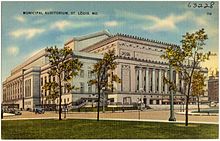Kiel Auditorium
 |
|
| Former names | Municipal Auditorium (1934–1943) |
|---|---|
| Location | 1401 Clark Avenue St. Louis, Missouri 63103 |
| Coordinates | 38°37′41″N 90°12′06″W / 38.627972°N 90.201782°WCoordinates: 38°37′41″N 90°12′06″W / 38.627972°N 90.201782°W |
| Capacity | 9,300 |
| Construction | |
| Opened | April 14, 1934 |
| Closed | 1991 |
| Demolished | 1992 |
| Construction cost | $6 million |
| Architect | Louis LaBeaume and Eugene S. Klein |
| Tenants | |
|
Saint Louis Billikens (NCAA) (1945–1968, 1973–1991) St. Louis Hawks (NBA) (1955–1968) St. Louis Streak (WPBL) (1979–1981) |
|
Kiel Auditorium was an indoor arena located in St. Louis, Missouri. It was the home of the St. Louis University basketball team and hosted the NBA's St. Louis Hawks, from 1955 to 1968.
The arena, completed in 1934, at a cost of $6 million, seated 9,300. It was originally named the Municipal Auditorium, but was renamed in honor of former St. Louis Mayor Henry Kiel in 1943.[1] A unique feature of the auditorium was that it was split into two; the front of the building was the Kiel Opera House. It was possible to use both sides at once as the stages were back to back. President Harry Truman gave a speech there in which both sides were opened to see his speech.
In 1955, the auditorium was also the venue for the second international conference of Alcoholics Anonymous, which established the service conference structure for the movement.
Kiel Auditorium played host to a variety of concerts and wrestling events, from the 1950s, until its closure in 1991. In 1983, it was the host of the Miss Universe Pageant. From the 1950s until the 1970s, the Kiel Auditorium was behind only Madison Square Garden as North America's most famous wrestling arena, hosting three NWA World Heavyweight Championship title changes from 1959 until 1986. The most notable wrestling event that took place at the Kiel Auditorium was WCW's premier event, Starrcade 1990. The building was demolished in 1992, but not before hosting the Missouri Valley Conference men's basketball tournament the preceding year.
After its demolition, its games and concerts temporarily went to the St. Louis Arena.
...
Wikipedia
